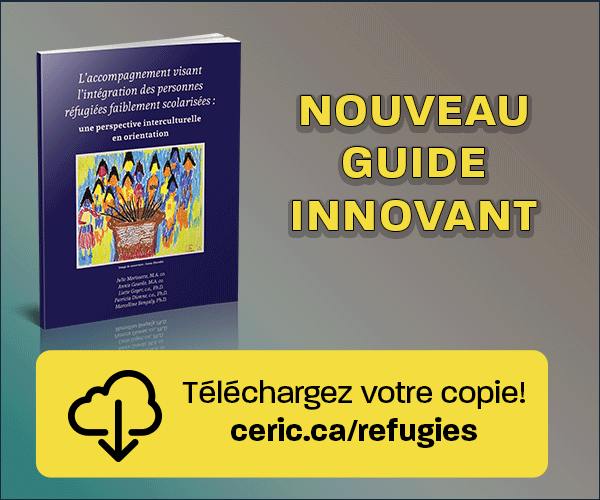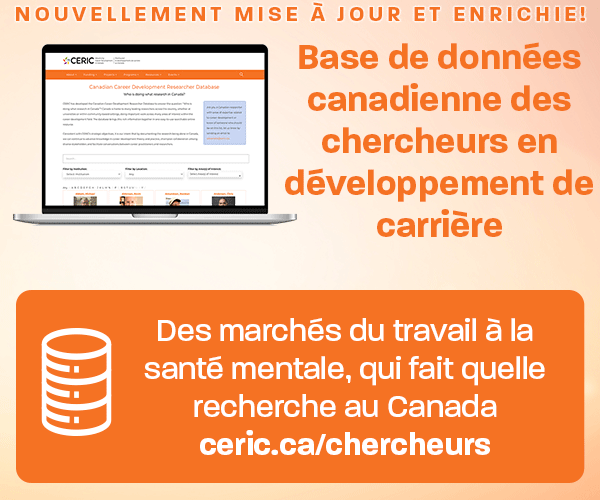Les jeunes femmes qui s’adaptent bien aux changements professionnels : les facteurs qui aident et ceux qui nuisent
Mots-clés :
les jeunes femmes, femmes, changement, travail, facteurs, épuisement professionnel, effectifs, psychologie positiveRésumé
This study responds to a call for an increased understanding of women workers and the importance of considering women’s experiences at different ages and stages of career involvement. Informed by positive psychology, this research looked at a small sub-set of working individuals, young women who selfidentified as doing well with changes affecting their work. The study focused on their experience of change, what strategies helped or hindered these young women in doing well, and what would have helped within the context of volatile and changing work conditions. The article describes the participants’ views regarding what change meant to them, along with the impact and result of changes they had experienced. Using the Enhanced Critical Incident Technique methodology (ECIT), the 10 participants reported a total of 147 helping and hindering, and wish list items. These break down into 85 helping incidents (58% of the total), 37 hindering incidents (25%), and 25 wish list items (17%) that were best represented by 9 categories: Friends and Family, Management and Work Environment, Skills Training and Self Growth, Personality Traits and Attitudes, Self-care, Personal Boundaries/Self Awareness, Take Action, School Pressure/Workload and Personal Change/Stressful Events. Implications for research, counselling practice and career counselling are discussed.
Références
Amundson, N. E., Borgen, W.A., Jordan S. & Erlebach, A. C. (2004). Survivors of downsizing: Helpful and hindering experiences. The Career Development Quarterly, 52,
-271.
Andersson, B., & Nilsson, S. (1964). Studies in the reliability and validity of the Critical Incident Technique. Journal of Applied Psychology, 48, 398- 403. doi: 10.1037/h0042025
Bender, A. & Farvolden, P. (2008). Depression and the workplace: A Progress Report. Current Psychiatry Reports, 10, 73-79.
Borgen, W.A., Butterfield, L.D. & Amundson, N.E. (2010). The experience of change and its impact on workers who self-identify as doing well with change that affects their work. Journal of Employment Counselling, 47, 2-11.
Bright, J., & Pryor, R. (2005). The chaos theory of careers: A user’s guide. The Career Development Quarterly , 291-305.
Braun, V. & Clark, V. (2006). Using thematic analysis in psychology. Qualitative Research in Psychology, 3, 77-101. doi: 10.1191/1478088706qp063oa
Butterfield, L.D., Borgen, W.A., Amundson, N.E. & Erlebach, A. (2010). What helps and hinders workers in managing change. Journal of Employment Counseling, 47(4), 146-156.
Butterfield, L.D., Borgen, W.A., Amundson, N.E., & Maglio, A.T. (2005). Fifty years of the Critical Incident Technique: 1954 - 2004 and beyond. Qualitative Research, 5, 475-497. doi:10.1177/1468794105056924
Butterfield, L.D. Borgen, W.A., Maglio, A.T., Amundson, N.E. (2009). Using the Enhanced Critical Incident Technique in counselling psychology research. Canadian Journal of Counselling, 4, 265-282.
Carver, C.S. (1998). Resilience and thriving: Issues, models and linkages. Journal of Social Issues, 54, 245-266.
Clayton, S., Carcia, A.L. and Crosby, F. J. (2010). Women in the workplace: Acknowledging differences in experience and policy. In L. Hope, & N. Russo (Eds.), Handbook
of diversity in feminist psychology (pp. 559-581). New York, NY: Springer. doi: 2010-02389-020.
Cocchiara, F. K., & Bell, M. P. (2010). Gender and work stress: Unique stressors, unique responses. In J. Quick, M. Schabracq, and C.Cooper (Eds.), Work and health psychology handbook (3rd ed.) (pp. 123-145). London, England: John Wiley & Sons Ltd. doi:10.1002/9780470682357.ch7
Flanagan, J.C. (1954). The critical incident technique. Psychological Bulletin, 51(4), 327-358. doi:10.1037/h0061470
Fouad, N.A. (2007). Work and vocational psychology: Theory, research, and applications. Annual Review of Psychology, 58, 543-564. doi:10.1146/annurev.psych.58.110405.085713
Goodman, J., Schlossberg, N.K., & Anderson, M.L. (2006). Counseling adults in transition: Linking practice with theory (3rd ed.). New York, NY: Springer Publishing
Company.
Grant, T. (2008, Spring). Stress, depression on the rise in workplace. Globe and Mail. Retrieved from http://www.theglobeandmail.com/report-on-business/article683066.ece
Grunberg, L. Moore, S. & Greenberg, E. and Sikora, P. (2008). The changing workplace and its effects. Journal of Applied Behavioral Sciences, 44, 215-236. doi:10.1177/0021886307312771
Hätinen, M., Kinnunen, U., Pekkonen, M., & Kalimo, R. (2007). Comparing two burnout interventions: Perceived job control mediates decreases in burnout.
International Journal of Stress Management, 14(3), 227-248. doi:10.1037/1072-5245.14.3.227
Martin-Fernandez, S. De los Rios, Cazorla, A. and Martinez-Falero, E. (2009). Pilot study on the influence of stress caused by the need to combine work and family on
occupational accidents in working women. Safety Science, 47(2), 192-198. doi:10.1016/j.ssci.2008.03.003
Murphy, K. A., Blustein, D. L., Bohlig, A.J. & Platt, M. G. (2010). The college-to-career transition: An exploration of emerging adulthood. Journal of Counseling and Development, 88, 174-181.
Parent, J. D. & Levitt, K. (2009). Employee perceptions of adaptability and work performance. The Business Renaissance Quarterly: Enhancing the Quality of Life at Work, 23-27.
Petitpas-Taylor, G. (2009). Naming workplace bullying: Women workers speak out. Retrieved March 3, 2010, from http://www.cwhn.ca/en/node/41612
Savickas, M. L. (2003). Advancing the career counseling profession: Objectives and strategies for the next decade. The Career Development Quarterly, 52(1), 87-96. doi:
-08153-010
Savickas, Mark L. (2005). The theory and practice of career construction. In S.D. Brown & R.W. Lent (Eds.), Career Development and Counseling: Putting Theory and Research to Work (pp. 42-70). Hoboken, NJ: John Wiley & Sons.
Schultheiss, D.E.P. (2006). The interface of work and family life. Professional Psychology: Research & Practice, 37, 334- 341. doi: 10.1037/0735-7028.37.4.334
Spreitzer, G., Sutcliffe, K., Dutton, J., Sonenshein, S., & Grant, A.M. (2005). A socially embedded model of thriving at work. Organization Science, 16, 537-549. doi:
1287/orsc.1050.0153
Super, D. E. (1980). A life-span, life-space approach to career development. Journal of Vocational Behavior, 16, 282-296.
Woolsey, L. (1986). The critical incident technique: An innovative method of research. Canadian Journal of Counselling, 20(4), 242-254

Téléchargements
Publié-e
Comment citer
Numéro
Rubrique
Licence

Cette œuvre est sous licence Creative Commons Attribution - Pas d'Utilisation Commerciale - Pas de Modification 4.0 International.











